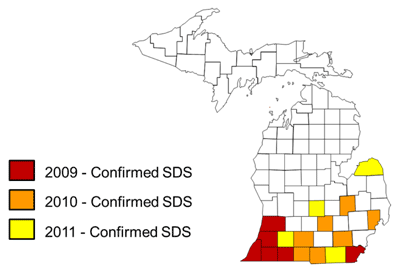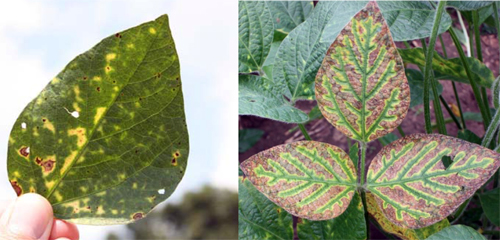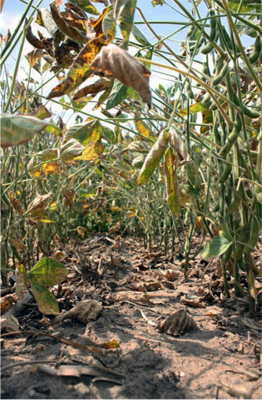Soybean sudden death syndrome found in four new counties in 2011
Lenawee, Kalamazoo, Clinton and Huron counties have been added to the list of those with soybean sudden death syndrome in fields this summer.
Unfortunately, soybean sudden death syndrome (SDS) has been found in new counties in 2011, including Lenawee, Kalamazoo, Clinton and as far north as Huron.

Although plants may be infected for the entire season it is not until reproductive growth stages that plants typically exhibit SDS symptoms. Symptoms include diffuse chlorotic spots which progress to interveinal chlorosis and necrosis, and premature leaf drop.

 Foliar fungicides are NOT effective against this disease, and there is no action that can be taken for this year’s crop. However, there are several management considerations to make for future planting.
Foliar fungicides are NOT effective against this disease, and there is no action that can be taken for this year’s crop. However, there are several management considerations to make for future planting.
- Have the disease positively identified as knowing which disease you are dealing with is critical in making management decisions.
- Prevent movement of SDS-contaminated soil from reaching your property with proper sanitation measures.
- Utilize soybean varieties with partial resistance (tolerance) to SDS.
- Manage soybean cyst nematodes (SCN) which can exacerbate the disease.
- Improve drainage as poor draining fields are more likely to develop SDS.
- Improve soil structure and prevent compaction, which can exacerbate SDS.
- If possible plant soybean fields known to be infested with the sudden death fungus last, as early planting tends to worsen disease.
Soybean sudden death syndrome is here to stay in Michigan. As in other northern states such as Wisconsin and Minnesota, it appears to be moving north and becoming more frequent. Crop rotation does not appear to help as the fungus is able to survive in the soil on organic debris. Seed treatments have also not proven to be efficacious; however we are still looking for potential new seed treatments. It is important to identify if you have this disease in order to manage any potential yield loss.
If you would like to have a plant sample positively identified for SDS, samples can be submitted free of charge to the following address. Collect the entire plant including roots and ship overnight. Please include contact information and sample location.
Martin Chilvers
Department of Plant Pathology
35c Plant Biology Bldg
178 Wilson Road
Michigan State University
East Lansing, MI 48824
Further information on SDS disease identification and management can be found in previous MSU Extension News articles and the website www.fieldcroppathology.msu.edu. You can also contact Martin Chilvers, MSU field crop pathologist, at 517-898-3049.
Related MSU Extension News article: Sudden death syndrome beginning to show symptoms in southwest Michigan soybean fields



 Print
Print Email
Email




